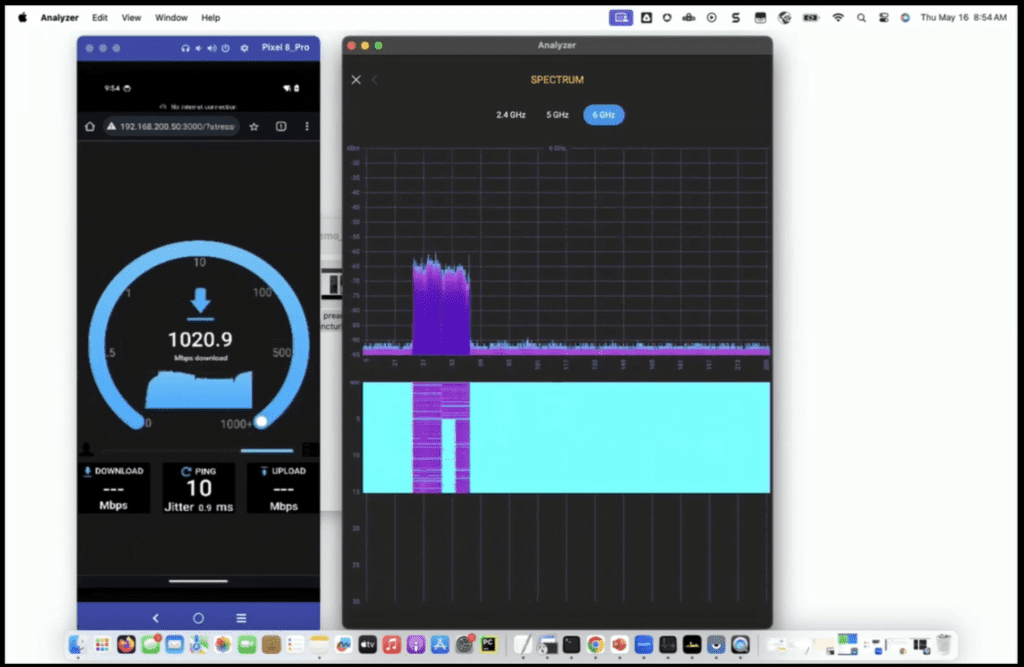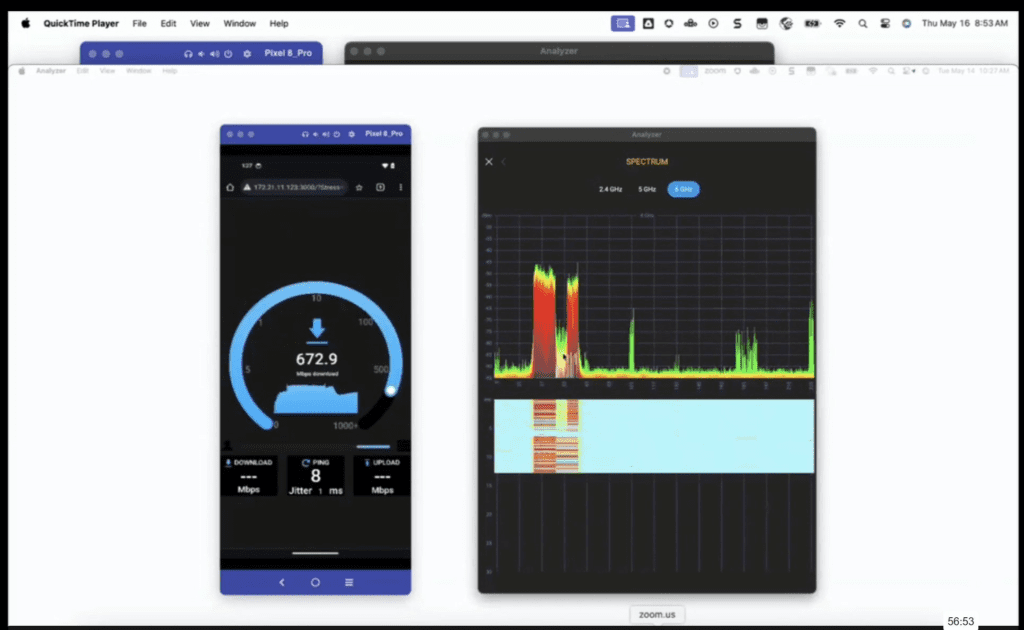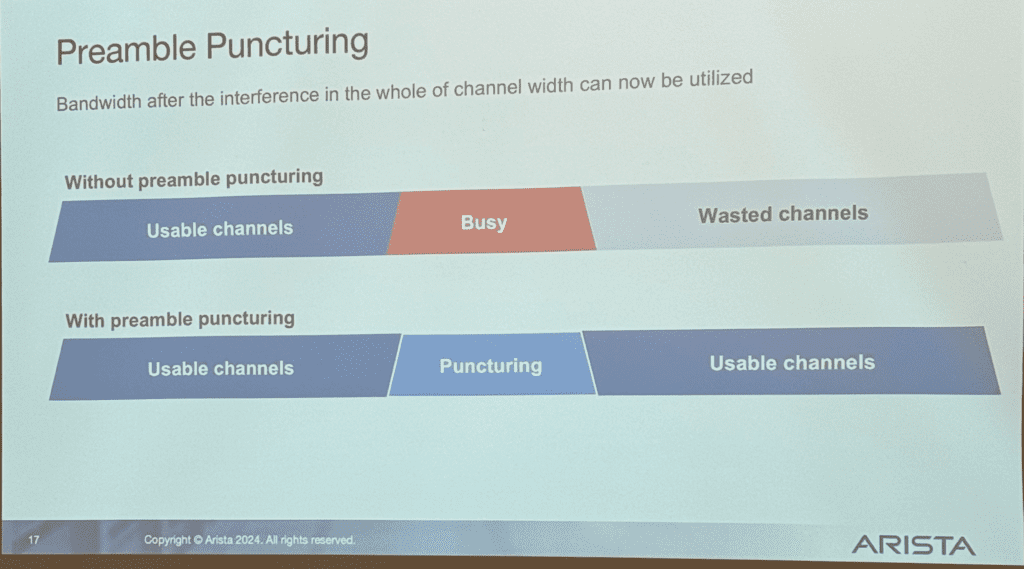The most unexpected presentation at Mobility Field Day 11 came from Arista Networks. Starting with showing off the most anticipated feature of Wifi 7, Multi-Link Operation they followed it up by showing off Preamble Puncturing.. The only thing that would have made it more unexpected was showing Preamble Puncturing in a live demo instead of a pre-recorded demo. Before be get into their demo, first lets talk about what they announced.
Arista Quality Code and Experience Focus
Although having now been a delegate at two Mobility Field Day events, where Arista Network presented, I have yet to try their gear. At Mobility Field Day 8, Arista talked about their improvements to root cause analysis and their new AGNI and AVA assistants, and their VXLANs that I talked about in a previous article. Fellow MFD8 delegate, John Kilpatrick, talked about the quality of their switching line. That was all that I knew of them at that time. Since then I’ve watch them improve their product line on the Wifi side post acquisition of Mojo Networks.

Arista started the day talking quality by their CTO and Co-founder, Ken Duda. Like John Killpatrick mentioned at MFD8, one of their focuses is to work on quality code to build a quality product. That focus on quality is a blessing and can be a curse. I commend them for the focus but not having touched their gear, I can’t speak to their quality verse the competition. Fellow delegate and mentor of mine, Keith Parsons, gave an excellent write up about the quality focus of Arista.
That focus on quality shows in their product line. They announced their Wifi 7 APs that are scheduled to be released Q3 or Q4 of this year.

U-PSK via QR Codes
One thing that has been lost due to the upgrade to WPA3-SAE from WPA2-PSK was the ability to do Multiple Pre-Shared Keys or User Pre-Shared Keys. Because of how keys are exchanged in WPA3-SAE, the infrastructure is unable to see the key… you know for security purposes. This prevents you from using multiple Pre-Shared Keys on an SSID without an additional piece of information such as a MAC Address. Many vendors are able to accomplish this but have to use a RADIUS server or manual entry of the MAC Address into the database. This is cumbersome. Ruckus was the first to come out with a solution, but many view it as a hack, where they downgrade the connection to WPA2-PSK temporarily to grab the key and setup the connection.
Arista on the other hand came up with an alternative, through the use of QR Codes. This method that is used heavily in the eSIM world on Cellular and Private Cellular networks is ingenious. Most people know how to use QR Codes in a post COVID restaurant world. The user is provided a QR code through either a self or guided registration process. They scan the QR code with their device that sets up the backend settings and keys. Then the device just joins without issues.

As a demo, the Arista team provided a QR code to Drew Lentz. Of course, everyone watching the live stream had to scan it as well.. including yours truly, and Drew got a flood of emails. Since it was a live demo, my device connected right up to the SSID, “Agni-Guest-UPSK”. Arista is the first to handle this problem with such a simple solution.

Wifi 7 Multi-Link Operation
After announcing their Wifi 7 lineup, they did a few things different than anyone else. They actually had gear turned on and broadcasting Wifi 7 networks in the room that we could join. That gave us a small difference than most of the other presentations because we could test things they were showing live during the demo. I was able to capture PCAPs using Airtool 2 and data using Wifi Explorer Pro on my Macbook Pro. While not Wifi 7, my Macbook Pro was able to capture the beacon frames right along with their demo.

What really stood out and gained the most impressions from the delegates and audience watching the live stream was their unexpected presentation showing off the headline features of Wifi 7 in action on their APs.

Wifi 7, as has been covered in many places, includes a feature where a client is able to talk to a single AP on multiple bands at the same time. This feature is called Multi-Link Operation or MLO. There are four different versions of MLO, and they only showed off one of them, eMLSR. As I was able to capture from the Live Demo with Wifi Explorer Pro 3, MLO adds some new EHT Extensions to the frames.

At WirelessLAN Professionals Conference (WLPC) in Phoenix, several attendees tested out MLO in one of the evening events. We used beta code from Ubiquiti and Netgear to test the new feature and were able to see it in action with a Spectrum Analyzer. Beyond that test, few have actually been able to see it in action. That changed during Arista’s presentation.
MLO Live Demos
Their first demo was showing an AP talking to a client on both 2.4GHz and 6GHz at the same time. For the demo, to show traffic they used OpenSpeedTest to cause traffic spikes with Ekahau Analyzer to show the Spectrum Analysis.

The SSID “MFD-11” was set to use MLO on channel 37 at 160MHz wide on 6GHz and channel 11 at 20MHz wide in 2.4GHz.

The test showed spikes while the speedtest was running on both 2.4 and 6GHz.

The second demo showed the same thing, but on both 5GHz and 6GHz.

It was using channel 100 at 80MHz wide on 5GHz and once again channel 37 at 160MHz wide in 6GHz.

Wifi 7 Preamble Puncturing
Another main feature of Wifi 7 that is discussed less was even more impressive. This was simulated by doing some magic on the AP side. For this to work properly, there should already be traffic on the channel that is causing the AP to block out a section of the channel so in the real world it wouldn’t look like this. But to make it visible, they had to make the AP think that portion of the channel was in use. It makes a really cool view on a spectrum analyzer. A normal use of the 80MHz wide portion looks like this (ignore the waterfall section from a previous test).

Now notice the “notch” in the middle, when they simulate interference on that third section of the channel.

Previously, if there was a single channel of a 80MHz wide channel in use, the device could only use the lower 40MHz of the channel. Now, the AP and Client are able to negotiate that they will use the lower 40MHz and upper 20MHz while leaving the third 20MHz wide portion for the interferer.

Since this one was simulated, I was unable to capture this during the demo. They did show what the PCAP will show. Under the EHT Operation extension, there will be a flag for “Disable Subchannel Bitmap Present: True”. Then the section below that will show “Disabled Subchannel Bitmap: 0x0030” for the third 20MHz section of the 80MHz wide channel. Preamble Puncturing is only available with 80MHz wide channels or higher.

These are the current capabilities that they have discovered with the few Wifi 7 clients that are out there.

I was pleasantly surprise by the quality of the presentation from the Arista team. We got an excellent presentation on that very topic and quality content was shared throughout. This is one presentation that I highly recommend you rewatch.


